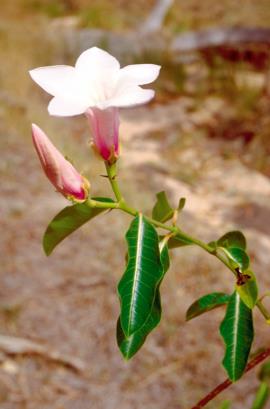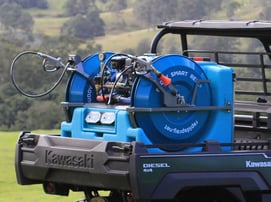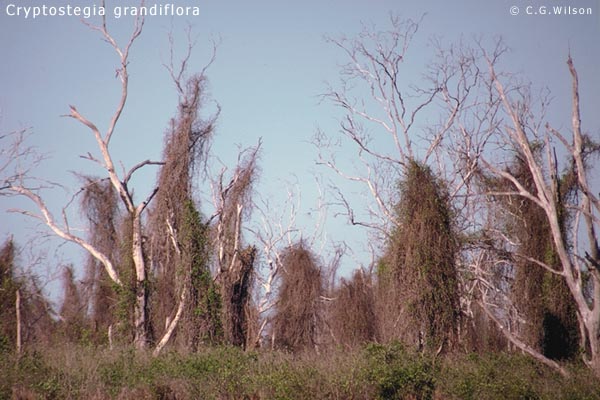Rubber vine has long been a weed many farmers curse, with its effects on animals ranging from a simple ailing, to the worst, death. Now, long after its introduction into Australia, farmers focus on managing and controlling this weed, but what are the best methods?
Where did it come from?
Rubber vine is native to southwestern Madagascar. It has become a weedy species in countries throughout East Africa, Southeast Asia, the United States and Central and Southern America.
In Australia it was planted in the 1860s in the gardens of mining towns in northern Queensland. Weedy infestations were reported by 1917. During the Second World War it was cultivated as a potential source of rubber, resulting in its further spread.
What is Rubber Vine?
Rubber vine is vigorous climber with whip like shoots that can grow unsupported to create an untidy 3m shrub, or a whopping 30m high if supported in trees. The roots can grow to a depth of 12m.
The stems, leaves and unripe pods exude a white, milky sap when broken or cut & the leaves are dark green and somewhat glossy 6−10cm long, 3−5cm wide.
Rubber vine also has flowers that are large and showy, with five white to light purple petals arranged in a funnel shape.
The seed pods are rigid and grow in pairs at the end of a short stalk. The pods are 10–12 cm long, 3–4 cm wide and each can contain up to 840 brown seeds. Each seed has a tuft of long, white, silky hairs, which enable easy dispersal by wind and water.

How does this weed affect you?
Rubber vine grows on all soil types, but successful germination is more likely on soils that retain moisture. Rubber vine is classed as one of the worst weeds in Australia because of its invasiveness, potential for spread, and economic and environmental impacts.
This weed has major impacts on pastoral and conservation areas of North East Australia and has the potential to spread into new areas.
READ OUR OTHER WEED CONTROL ARTICLES:
BLACKBERRIES | FEATHERTOP RHODES GRASS | SOW THISTLE | LANTANA
Its main impact on pastoralism is the loss of grazing country, it increases the costs of mustering and fencing. It also threatens waterways, woodlands and rainforests, including significant conservation areas such as the Wet Tropics World Heritage Area and Cape York.
It also severely threatens riverine vegetation, and can potentially displace the plants and animals that inhabit riverbanks, thereby affecting the water quality of streams. It is also because of this intense growing behaviour, the rubber vine can often be quite hard to get to and therefore, eliminate.
The whole ecological integrity of native vine thickets and riverine systems is under threat from rubber vine.
Germination
Seeds germinate with the break of the wet season. Rubber Vine seeds have high levels of viability and can stand 6-8 months of drought.
Germination is greater in the dark and at temperatures between 25 and 300C.
Control & Effects
In horses - loss of appetite, dullness, harsh coat, aimless walking, abdominal pains, collapse and death.
In cattle - loss of appetite, diarrhoea, laboured breathing, abdominal pains, collapse and death.
You must report this plant if you see it anywhere in NSW. Call the helpline listed above. Help will then be provided to remove and destroy it. This serious weed could spread if control efforts do not follow all protocols. Not reporting it is a breach of your legal biosecurity duty.
You can report your rubber vine infestation to the following:
| STATE | DEPARTMENT | PHONE | WEBSITE | |
| NSW | NSW Agriculture | 1800 680 244 | weeds@agric.nsw.gov.au | www.agric.nsw.gov.au |
| NT | Dept of Infrastructure, Planning and Environment | 08 8999 5511 | weedinfo.ipe@nt.gov.au | www.nt.gov.au |
| QLD | Dept of Natural Resources and Mines | 07 3896 3111 | enquiries@nrm.qld.gov.au | www.nrm.qld.gov.au |
| WA | Dept of Agriculture | 08 9368 3333 | enquiries@agric.wa.gov.au | www.agric.wa.gov.au |
| AUS wide | Australian Pesticides and Veterinary Medicines Authority | 02 6272 5852 | contact@apvma.gov.au | www.apvma.gov.au |
Management & Controls
All control of rubber vine will require follow-up treatments to keep your property clean. As rubber vine spreads quickly, small infestations should be controlled first to prevent them from becoming major problem areas. Dense infestations are difficult and costly to treat.
Rubber Vine can be controlled by a number of options, however the below two options seem to have the best impact on the spread of the weed:
Fire: Rubber vine infestations can be very effectively controlled by burning. Preparing and managing fuel load prior to burning, and following up in a timely manner after the fires, are critical to the overall success of the program. It is recommended that you perform two successive annual burns. The first fire will open up the infestation to increase grass growth (fuel load) while killing rubber vine plants. The second fire will clean up the regrowth that occurs after the first fire. An appropriate fire regime is an effective tool for managing rubber vine over the long term, as well as being an effective follow-up to other control methods.
Herbicide control: This method gives a high level of control although it is not as effective on multi-stemmed plants as Fire as it is difficult to spray each stem completely around the base. Thoroughly spray around the base of the plant to a height of 20−100 cm above ground level, spraying higher on larger plants. Optimum results are attained when the plant is actively growing.
FOR EFFECTIVE AND FAST WEED CONTROL
 The SpraySCout
The SpraySCout
Our most nimble sprayer yet, the SprayScout has been designed to enable you to access those hard to reach locations. Made from highly durable yet lightweight materials, it can fit comfortably on the back of an RTV, giving you the spray-power you want and the mobility you need.
References:
http://weeds.dpi.nsw.gov.au/Weeds/Details/168
http://www.herbiguide.com.au/Descriptions/hg_Rubber_Vine.htm





